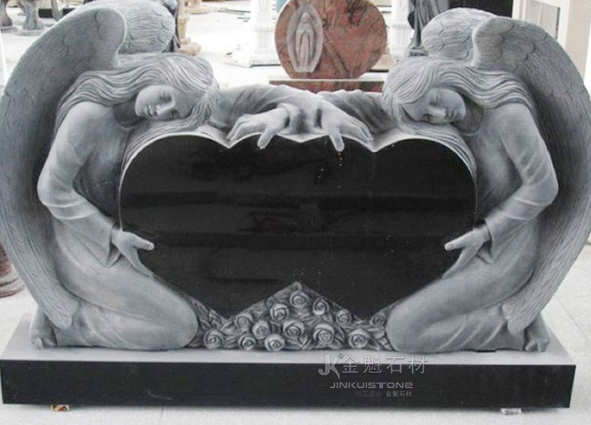Did you know that here at Family Memorials about 95% of all the headstones we sell are made of granite? That means we go through A LOT of granite every year!
Why is granite the material of choice for nearly every monument we sell? Is granite used for anything other than gravestones? Why are there so many colors of granite? What is granite in the first place?
Well, these are the questions we're going to look at in this post. We'll start with a look at what granite actually is and how it’s formed. Let's go!

Angel Headstones
To begin, the word “granite” has its origins in the Latin “granum” which means grain. The Latin word is a clear reference and/or description of the granular crystalline structure that is clearly visible in any piece of granite.
We won’t go into all the technical definitions regarding what percentage of the rock has to be quartz or feldspar in order for it to qualify as granite, but most granite consists mainly of quartz and feldspar and has various quantities of mica and a variety of other amphibole minerals. (If you’d like to see all the technical descriptions, check out this Wikipedia article.)
Typically, the quartz and feldspar will form a tight, interlocking structure with the other minerals scattered throughout, sometimes evenly and others not so evenly. This creates a very uniform and tight composition which causes the granite to be a hard, dense, and tough natural material.
This tight crystalline structure also means water has a very difficult time penetrating into the stone making it quite durable and able to stand up to inclement weather for very long periods of time (we’re talking centuries and even millennia) without losing its structural integrity.
These characteristics and qualities have caused granite to be a reliable construction material for thousands of years. Nowadays it’s also the primary choice of material for monuments and headstones around the world. What better way to ensure your memory is captured in stone for centuries to come?
If you can remember back to your schooling days, you may recognize the general category of rock called Igneous. Granite is an igneous rock which means it was formed from cooling magma (basically underground hot lava).
In order for the crystalline structures that exist in granite to have been created, this cooling process must have happened slowly over thousands of years and at pressures only possible far beneath the earth’s surface.
As a result, any granite that is visible to the naked eye at or above the surface of the earth has either been pushed upward by the movement of the Earth’s tectonic plates or all the other stuff (sand, dirt, etc.) has eroded away leaving the granite exposed.
Believe it or not, granite is found all around the world and, in fact, most of the Earth’s surface has granite underneath the visible layers of sedimentary materials such as dirt, sand, and other organic materials.
Did you know that most of our world’s tallest buildings are firmly anchored to the granite located directly underneath them? In reality, how solid the granite underneath a building site is determines how tall a building can safely be.
If you look at the island of Manhattan, you’ll notice there are really only to areas on either end of the island where the tallest buildings exist. This isn’t due to economics or land value, but rather the accessibility and quality of the granite under the island.
In the center of the island, the granite is too far underground to be used for construction, so the building heights are limited, whereas, on the ends where the granite is closer to the surface, engineers can ensure their skyscrapers will be anchored to a solid foundation and, therefore, the building heights continue to break records. For more regarding this interesting granite-related topic, check out this article.
Most mountain ranges and large rock outcroppings are actually made of granite that is being forced upward by the earth’s plates being pushed around. The Rocky Mountains are a great example of this. Mount Rushmore and Crazy Horse are two giant sculptures located in the Black Hills of South Dakota that are literally carved or being carved into granite mountains.
● Granite is a very hard natural material, which means it is fairly resistant to chipping and scratching, especially when compared to other natural stones such as marble or sandstone.
● Granite is also quite strong which means it can bear a lot of weight. This makes it a great material for building construction.
● Granite is also a very dense, tight material which means it is resistant to weather over long periods of time.
● Granite can be polished to a beautiful, glossy sheen which pulls out the beautiful colors and intricacies hidden within its grains.
Granite can come in a variety of colors from very light and dark grays to midnight black, to blue, green, red, pink, orange, and just about anything in-between. You can check out all the colors of granite we typically use on this page.
Ultimately, the wide color varieties within granite from different locations are determined by the mineral make-up of the granite in that particular geographic area.
There are some colors, such as gray and black, that can be quarried in various parts of the world and have just about the exact same colors and patterns. However, there are other colors, such as some blues and greens, that are completely unique to particular parts of the world or geologic features. For example, Norway is known around the world for the beautiful blue granite that can only be found in Norwegian granite formations.
We have a wide variety of Angel Headstones made from the finest granite. Welcome to contact us.
Copyright © Hebei Jinkui Stone Co., Ltd. All Rights Reserved | Sitemap
| Powered by
